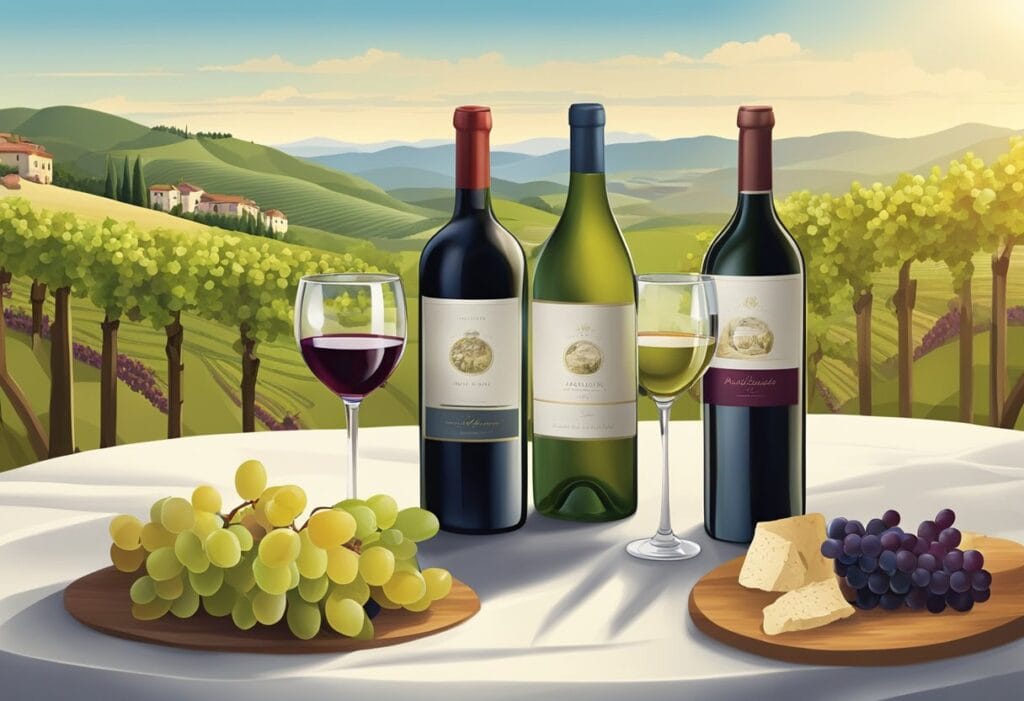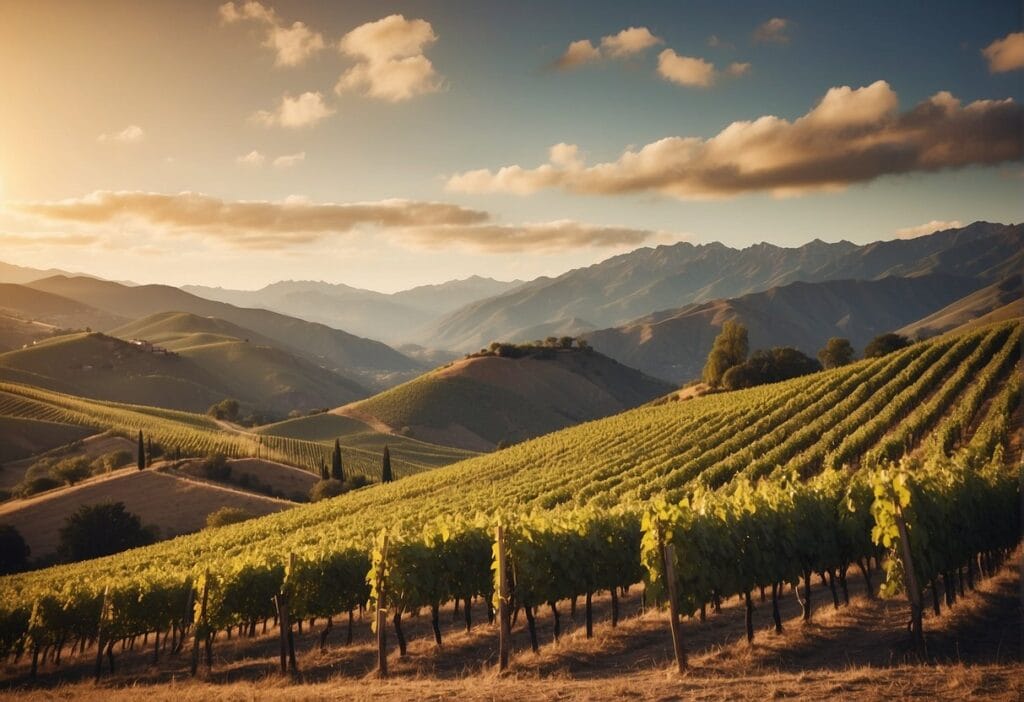As you explore the world of French wine, you’ll discover a mosaic of regions, each with its own identity, shaped by the concept of terroir. France is not just a country of wine, but a culture where wine is intricately woven into the fabric of its history and gastronomy.
With prestigious appellations, such as Bordeaux, Burgundy, and Champagne, each sip provides a taste of the specific area where the grapes were grown. The diversity found within these regions is vast, offering wine enthusiasts an array of flavors and styles to savor.
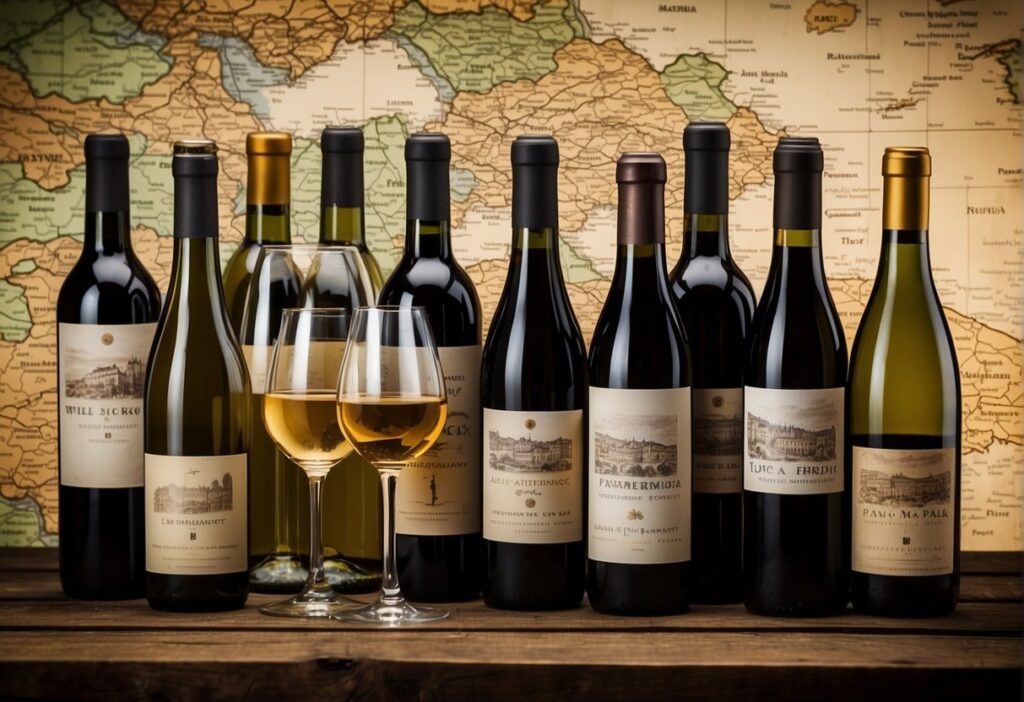
Understanding the intricacies of French wine begins with a familiarity with appellations controlled by the AOC (Appellation d’Origine Contrôlée) and AOP (Appellation d’Origine Protégée) systems. These are navigational tools that guarantee authenticity and quality.
The AOC and AOP labels ensure that each bottle you uncork adheres to strict regulations, from the type of grapes used to winemaking processes. By mastering the nuances of the labels, you equip yourself with the knowledge to fully appreciate the craftsmanship behind each bottle.
Venturing through the vineyards and winemaking establishments across France is not just about tasting, but experiencing a centuries-old tradition that continues to evolve and enchant the wine industry today.
Key Takeaways
- French wine regions offer a varied palette of flavors, each influenced by its unique terroir.
- Appellation systems like AOC and AOP guide the authenticity and quality of French wine, reflecting its regional character.
- Tasting French wine is an immersive experience that unveils the deep-rooted traditions and evolving practices of the nation’s wine industry.
Major French Wine Regions
As you explore the world of French wines, you’ll discover that each region offers a distinct palette of flavors shaped by the unique landscapes and winemaking traditions. Embark on a journey through France’s renowned wine-producing areas, each with its own signature varietals and styles.
Bordeaux
In the Bordeaux region, nestled along the Gironde Estuary, you’ll find a range of robust red wines, primarily made from Merlot and Cabernet Sauvignon grapes. This region is known for prestigious vineyards that produce wines with a reputation for elegance and depth.
Burgundy
Burgundy is famous for its complex Pinot Noir and Chardonnay wines. The vineyards here capitalize on a rich history and a diverse terrain, which contribute to the highly sought-after wines that express the terroir with great fidelity.
Champagne
The Champagne region is synonymous with its sparkling namesake wine. Here, tradition blends with rigorous standards to create the effervescent Champagne, a global symbol of celebration.
Rhône Valley
Experience the bold, spicy reds of the Rhône Valley, where Syrah is king. This region also offers sumptuous Grenache-based blends that exude the warmth and flavor intensity typical of the area’s terroir.
Alsace
Alsace prides itself on aromatic white wines like Riesling and Gewürztraminer. Exploring Alsace’s wine route reveals a picturesque blend of German and French winemaking cultures.
Loire Valley
In the Loire Valley, diversity is key, with wines ranging from crisp Sancerre to the delightful sparkling Crémant de Loire. The region’s châteaux-dotted landscape is as elegant as the wines it produces.
Provence
Venture into the heart of Provence for a taste of its famous rosés. Here, the sun-drenched vineyards yield wines that are as refreshing as a Mediterranean breeze.
Languedoc-Roussillon
Finally, the Languedoc-Roussillon offers a treasure trove of wine styles. From the shores of the Mediterranean to the Pyrenees, this large, dynamic region is gaining acclaim for its innovative and quality-driven approach to wine.
Understanding Appellations
When you explore French wines, you’ll discover that appellations are at the heart of understanding the origin and quality of what you’re enjoying. They’re a legal framework that ties the wine to the land, ensuring you get authenticity and quality linked to a specific region, known as the terroir.
AOC and AOP
The Appellation d’origine contrôlée (AOC) is the French certification granted to certain French geographical indications for wines, cheeses, and other agricultural products, based on the concept of terroir. The Appellation d’origine protégée (AOP) is essentially the EU equivalent of the AOC, often used in marketing to connote the same standards for quality and area-specific production.
IGP and Vin de France
On a step below the esteemed AOC/AOP, you’ll find Indication Géographique Protégée (IGP), identifying wine that comes from a specific region and conforms to certain quality standards. The Vin de France category offers more flexibility, allowing winemakers to blend grapes from different regions. This results in wines that are labeled with the grape variety rather than a specific region and have a broader, more varied character.
Grand Cru and Premier Cru
Delving deeper into wine labels, Grand Cru and Premier Cru are classifications within certain AOCs that signify the highest-ranking vineyards and are based on strict criteria including the terroir, reputation, and quality. Grand Cru designates the very best lands and is a term most notably associated with the vineyards of Burgundy and Alsace, whereas Premier Cru indicates a high but not the highest level of quality among vineyards.
The Grapes of French Wine
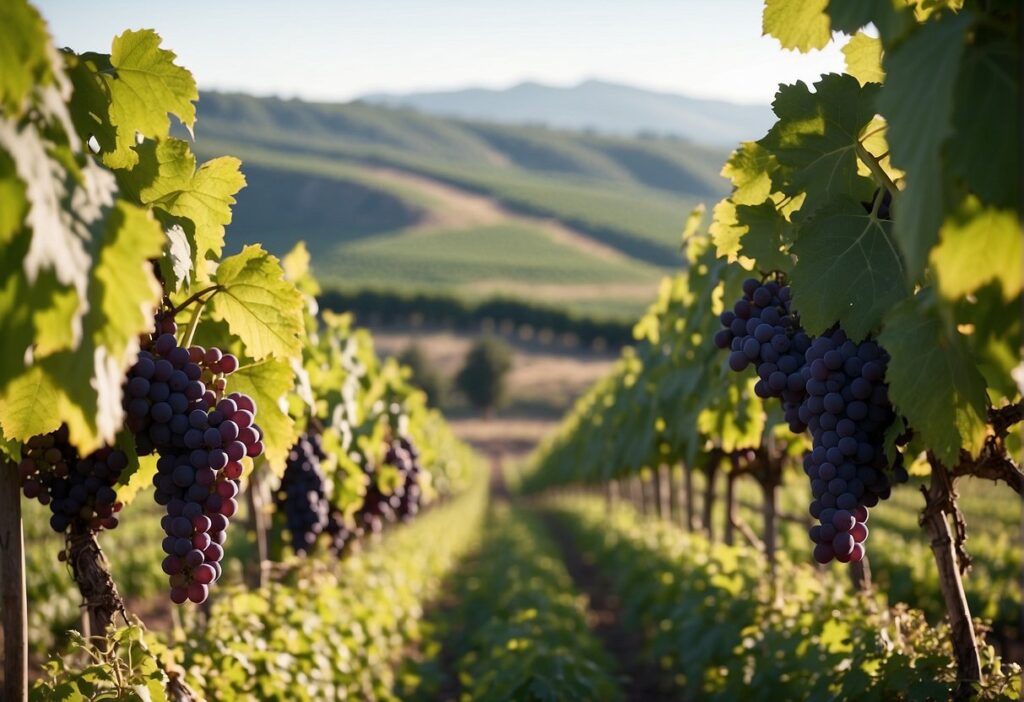
France offers a diverse palette of wine grapes that each contribute to the country’s renowned wine profiles. From the robust reds to the crisp whites, you’re about to uncover the core of French viticulture.
Red Grape Varieties
In the rich tapestry of French red wines, several grapes stand out. Cabernet Sauvignon and Merlot are the backbone of Bordeaux’s famous blends. The Syrah offers a spicy essence, particularly in the Rhône region, giving birth to robust wines with profound depth. Grenache joins the fray, imparting berry-like flavors, especially valuable in Southern France. Pinot Noir, primarily from Burgundy, is cherished for its elegance and complexity.
- Syrah: Dominant in Rhône, noteworthy for spice and vigor.
- Merlot: Versatile, from Bordeaux, lush and fruity.
- Cabernet Sauvignon: Structured, from Bordeaux, ages gracefully.
- Pinot Noir: Complex, from Burgundy, with a delicate finesse.
- Grenache: Berry flavors, common in Southern France, offers warmth.
White Grape Varieties
Chardonnay takes the lead in Burgundy, expressing a range of styles from the minerally Chablis to the opulent wines of Meursault. Sauvignon Blanc is the star in Loire Valley, giving zest to Sancerre and Pouilly-Fumé. Chenin Blanc shows versatility from dry to sweet, while Viognier shines with floral aromatics, perfect for a fragrant and full-bodied glass.
- Chardonnay: Adaptable, from Burgundy, with a spectrum of expressions.
- Sauvignon Blanc: Zesty, predominant in Loire, crisp and fresh.
- Chenin Blanc: High acidity, from Loire, dry to honeyed sweet.
- Viognier: Floral, mainly in Rhône, full-bodied and aromatic.
Popular Types of French Wine
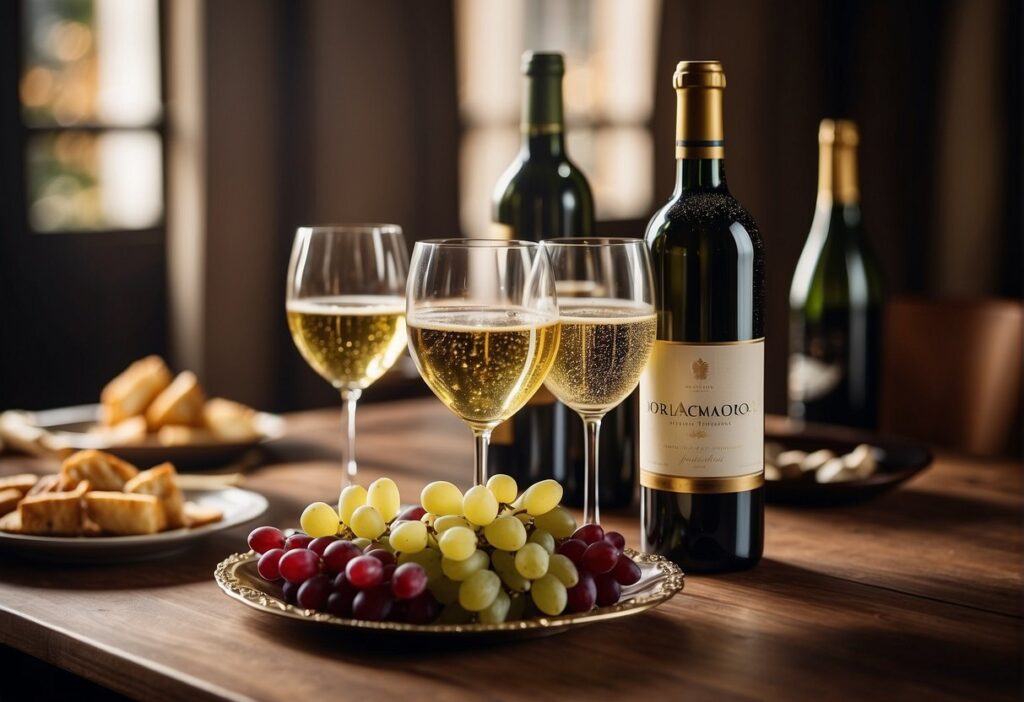
France offers an incredible diversity in wines, each type rich in history and unique in taste. You’ll discover the pride of specific regions and the heart of French winemaking tradition through the variety of flavors in reds, whites, rosés, sparklings, and fortified wines.
Red Wines
Bordeaux and Châteauneuf-du-Pape are standout red wines known for their depth and complexity. Bordeaux is renowned for its blend of grapes, primarily merlot and cabernet sauvignon, giving it that perfect balance of richness and elegance. For a powerful red blend, you’ll find Châteauneuf-du-Pape, with its bold flavor profile, intriguing.
White Wines
From the crisp Chablis to the aromatic Sancerre, white wines in France are as diverse as they are flavorful.
A must-try is the White Burgundy, with its renowned blend of chardonnay grapes, offering a smooth and rich tasting experience.
Then there’s Vouvray, a chenin blanc that can range from dry to sweet, versatile enough to match any palette.
Rosé Wines
French rosé wines, particularly those from Provence, are refreshing and ideal for warmer days.
They typically have a delicate balance of sweetness and acidity, creating a perfect aperitif or companion to light meals.
Sparkling Wines
Nothing says celebration quite like a bottle of Champagne, the epitome of French sparkling wines produced using the traditional méthode champenoise.
Don’t overlook Blanquette de Limoux, though—it claims to be the oldest sparkling wine and remains a well-kept secret.
Fortified Wines
Sweet and sumptuous, Sauternes is a luxurious dessert wine from the Bordeaux region, with rich, honeyed flavors that linger on your palate.
This type of wine offers a perfect end to any meal, or a sublime pairing with creamy blue cheeses.
French Wine Label Terminology
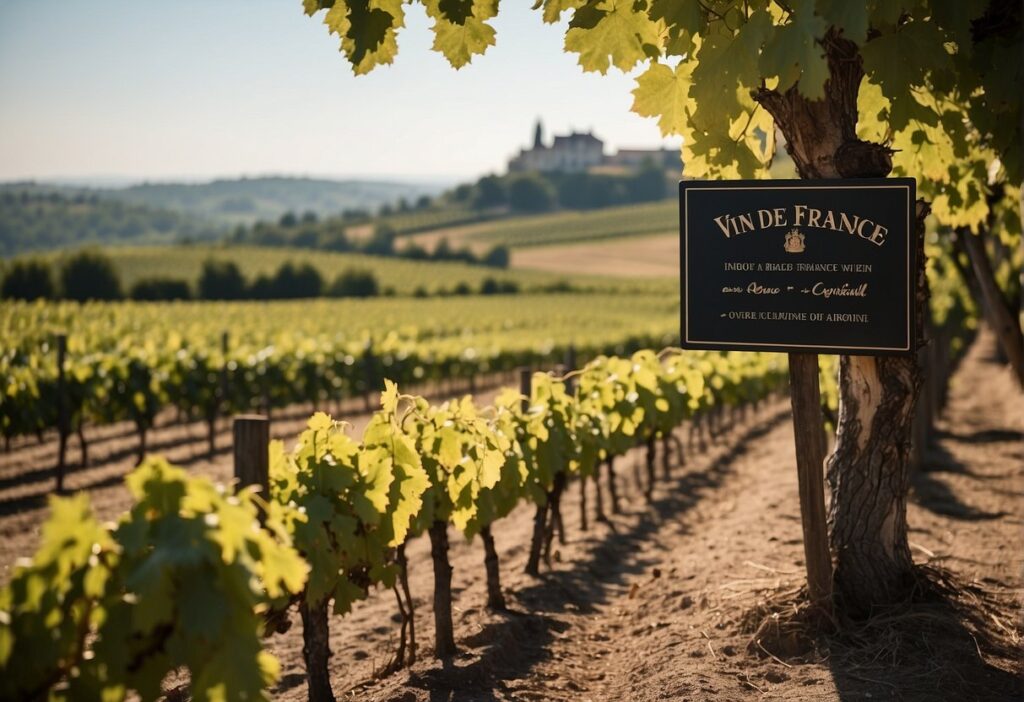
Navigating French wine labels requires familiarity with certain key terms that reflect the terroir, classification, and origins of the wine you’re exploring.
Understanding Wine Labels
When you look at a French wine label, you’re getting a glimpse into the wine’s backstory.
Appellation d’Origine Contrôlée (AOC) is a term you’ll often encounter, which translates to “Controlled Designation of Origin.”
This designation is your guarantee that the wine meets strict regulations concerning where the grapes are grown, how they are produced, and the wine’s terroir—the unique environment including the soil, climate, and topography where the grapes are cultivated.
French wine labels may not always list the grape variety, a practice unlike many New World wines.
Instead, they focus on the region, which implies certain grape varieties and wine styles.
For example, if you pick up a bottle from a winery in Burgundy, it’s typically made with Pinot Noir or Chardonnay grapes.
Decoding Quality Levels
Understanding the quality levels on French wine labels helps you predict the taste experience. Here’s a quick guide to decoding these levels:
- AOC (Appellation d’Origine Contrôlée): This top tier indicates wines that must adhere to the most stringent production standards and is a mark of quality.
- Vin de Pays (VDP): This designation refers to “country wines” that have fewer restrictions than AOC wines but still must follow certain regional qualities.
- Vin de Table: Simple table wines that are not bound to any regional rules or specific grape varieties.
Remember, a higher classification doesn’t always mean a better wine for your taste; it’s a starting point for understanding what’s behind a label.
Each tier reflects the level of regulatory control over the production, which influences not just quality but also the flavor profile and the wine producer’s methods.
The AOC system ensures that each wine is a true representation of its region and terroir.
The Winegrowing Landscape
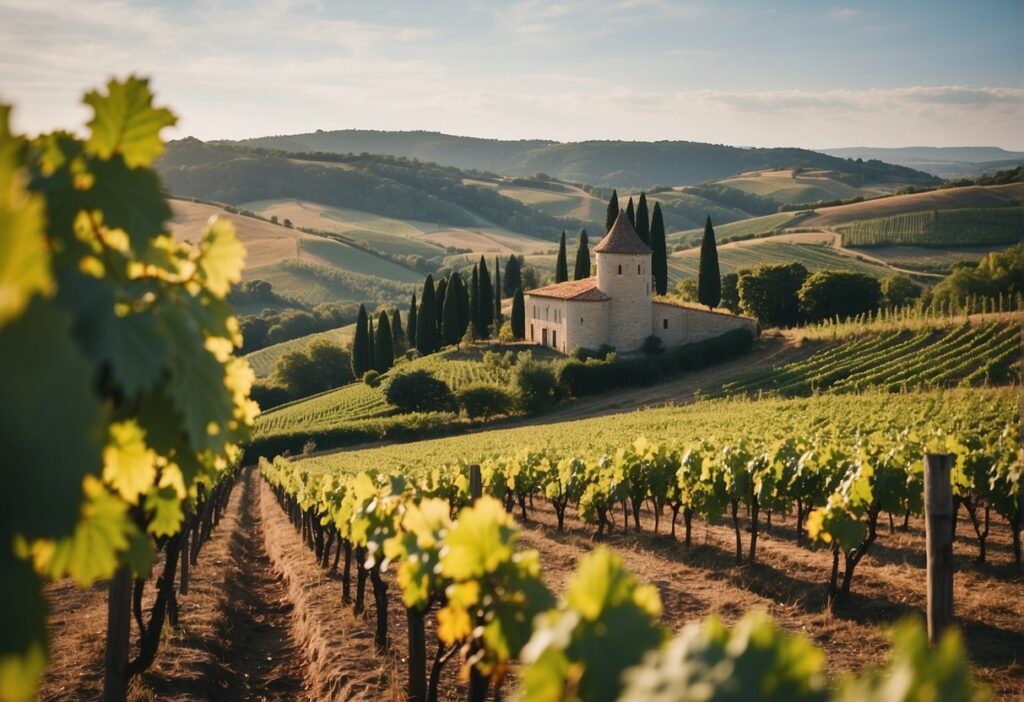
France’s vineyards are as diverse as they are numerous, with each region offering a unique interaction between the terroir and the local climate.
Understanding how these elements influence the wine is key to appreciating the subtleties of French viticulture.
Terroir and Its Influence
Terroir is a term that encapsulates the environmental characteristics that affect a vineyard’s produce, including soil type, topography, and microclimate.
It’s the reason why a grape variety from one region can produce a vastly different wine from the same variety grown elsewhere.
For example, the subtle mineral nuances found in a Chablis can be attributed to the Kimmerician clay found in Burgundy’s vineyards.
The Role of Climate and Geography
Climatology and geography shape the personality of the wine you enjoy.
Regions such as Bordeaux benefit from the moderating influence of the Atlantic, ensuring a temperate climate ideal for varieties like Cabernet Sauvignon and Merlot.
In contrast, the Syrah vines in the Rhône Valley thrive under the warm Mediterranean sun, bolstered by the shelter and heat retention provided by the surrounding hills and river.
Cultural Significance
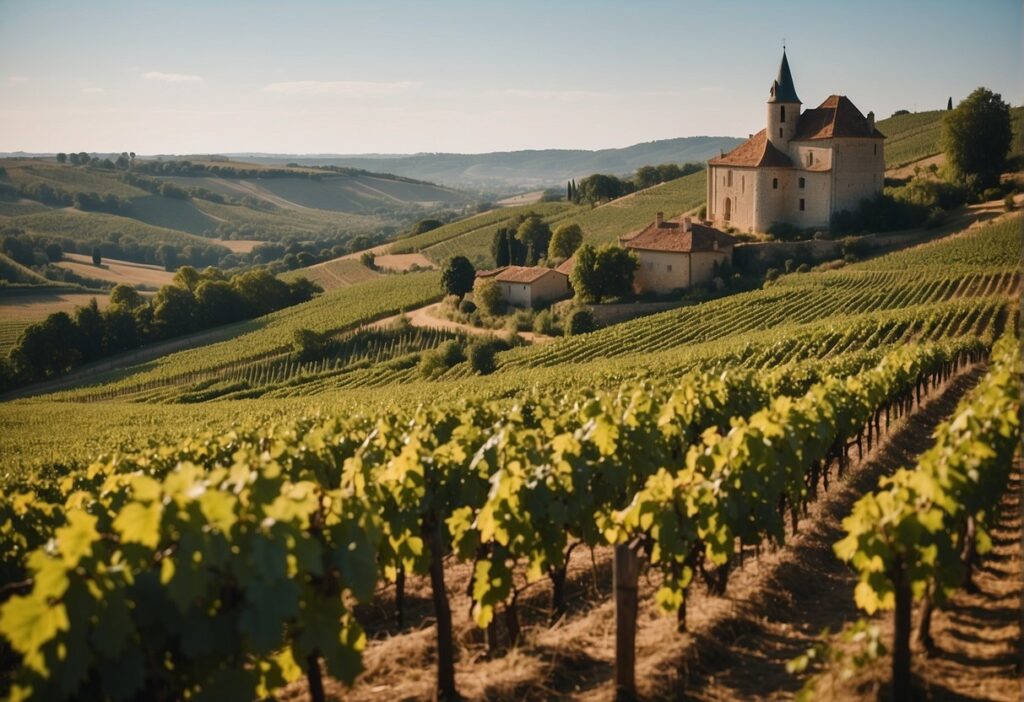
In exploring the cultural roots of French wine, you’ll discover that monks played a pivotal role in its development and that France’s vinicultural offerings have significantly shaped the global wine industry.
Monks and Winemaking
Monks have been instrumental in France’s winemaking traditions.
They cultivated vineyards, honed the winemaking process, and preserved these methods through the ages.
Your bottle of Burgundy owes much to their expertise, specifically Cistercian and Benedictine monks, who were some of the earliest vintners.
French Wine in Global Context
French wine stands as a benchmark in the global wine industry.
It has influenced winemaking techniques and standards worldwide.
When you pour a glass of wine, wherever it’s from, the chances are high that its production has been informed by practices developed in the vineyards of France.
Wine Tasting in France
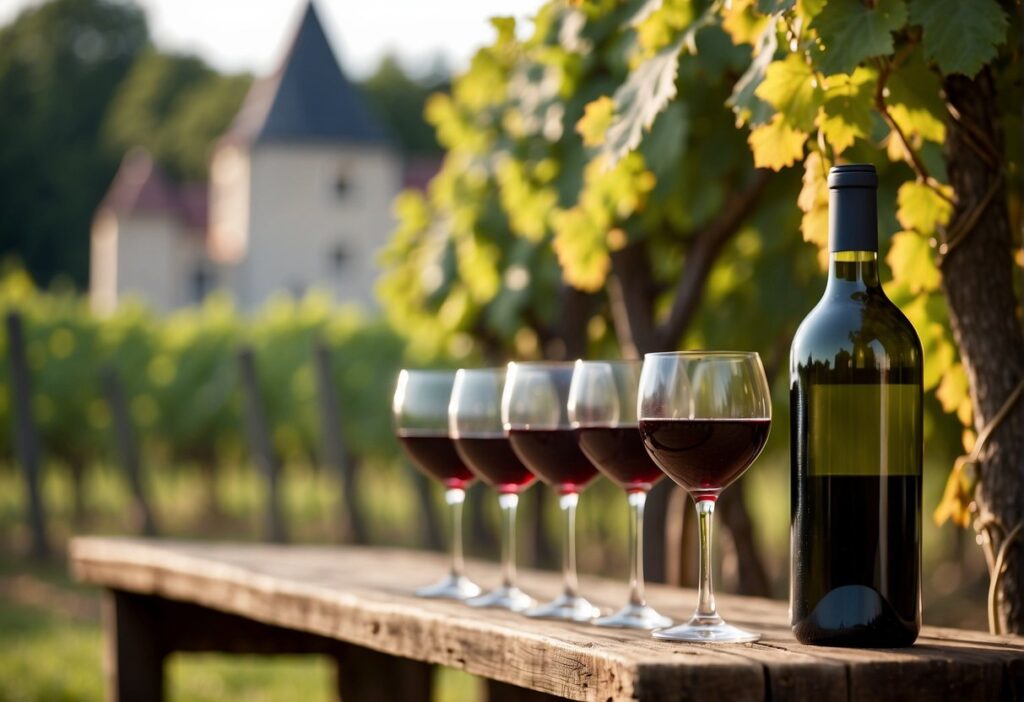
Embark on an exciting journey through France’s storied vineyards, where you can savor the richness of French wines directly from the source.
Wine tasting in France is not just about the wine itself; it’s about the experience that comes with each glass, the scenic vineyards, and the art of pairing these exquisite wines with the country’s famed cuisine.
Wine Tours and Tastings
France offers a multitude of wine tours that can take you through various regions, each with their unique grape varieties and wine styles.
From the lush valleys of Bordeaux, renowned for its red wine production, to the picturesque hills of Champagne, where you can taste the world-famous sparkling wines, the options are limitless.
- Alsace: Home to Pinot Gris, this region flaunts its potential with a white wine variety originally from Burgundy. Discover more about the wines from this region with a guided wine tour in Alsace.
- Loire Valley: Here, you can explore a diverse range of wine styles including white, red, rosé, and sparkling wines.
Grape varieties like Sauvignon Blanc and Cabernet Franc are stars in this central French haven. Find the right tour for your palate through offerings like Loire Valley wine adventures.
Tip: Choose a wine tour that offers not just tastings but also educational insights into the winemaking process, grape harvesting, and history of the region.
Pairing French Wine with Food
One of the joys of wine tasting in France is learning how to pair the rich bouquet of French wines with the perfect dish.
French cuisine, known for its finesse and flavor, complements the country’s wines, enhancing both the meal and the tasting experience.
- Bold Reds: Pair a robust Bordeaux with a hearty beef stew.
- Crisp Whites: A glass of chilled Sauvignon Blanc from Loire Valley goes hand in hand with a delicate seafood platter.
Food tours, which often combine wine tastings with culinary experiences, are an excellent way to indulge in authentic French farm-to-table cooking.
Harmonize your taste buds with the classic French pairings found in experiences like those offered around Pic Saint-Loup.
Remember, the key to pairing is balance; let the wine and food complement each other without overpowering one another.
Drink, eat, and learn as you go – this is the essence of French wine culture.
Preserving and Collecting
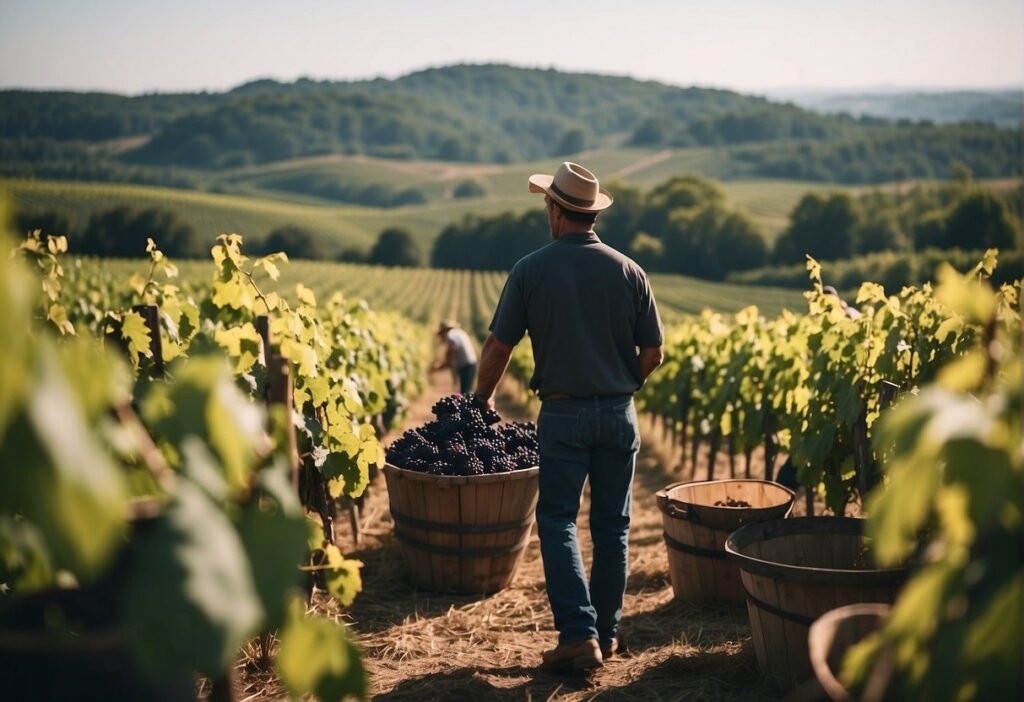
When it comes to French wine, understanding storage and preservation methods coupled with savvy investment approaches can enhance your collecting journey.
Wine Storage and Preservation
To preserve the quality of your French wine, control the environment where the bottles are stored.
Ideal conditions include a constant temperature of about 12-14°C (55-58°F) and a humidity level around 70%.
Ensure your bottles are kept out of direct sunlight and store them horizontally to keep the corks moist, preventing unwanted air from seeping in.
Proper storage is crucial not only for maintaining the integrity of the wine but also for ensuring that it ages gracefully.
For example, sweet wines from Sauternes or Montbazillac require a high natural sugar level for preservation.
Similarly, acidity plays an essential role, especially in white French wines, including those that are sparkling.
Investing in French Wines
Investing in French wines can be rewarding, but it’s essential to be well-informed about what makes a wine valuable.
Focus on regions known for their investment-grade wines, such as Bordeaux or Burgundy. Wines from these regions often have a proven track record for aging well and increasing in value over time.
Remember that factors influencing a wine’s investment potential include its rarity, vintage quality, producer’s reputation, and appellation.
It’s advisable to diversify your portfolio with a mix of ready-to-drink wines and long-term investment bottles.
Keep in mind that investing in wine carries risks like any other investment, but your understanding of French wine classifications and labels can help mitigate them.
